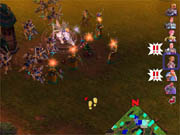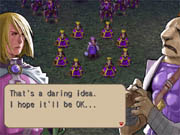Real-time strategy games are more common than any other kind of PC game. Over the last five years, countless games have tried to combine strategic decision making with elements of pure action. Some real-time strategy games, including classics such as Westwood's Command & Conquer and Blizzard's Starcraft, became so popular that they were ported from the PC to various video game consoles, where they met with still more success. Games like these clearly inspired Hundred Swords, a simple but distinctive game that was originally released a year ago in Japan for the now-defunct Sega Dreamcast console. Created by Smilebit, a company known for its inspired graffiti game Jet Grind Radio, Hundred Swords is now available in the US, for the PC, in English, and for a retail price of less than $20. If for no other reason, Hundred Swords deserves credit for being the first of its kind--a PC port of a real-time strategy game originally designed for consoles.

Hundred Swords isn't the greatest real-time strategy game you'll ever play. Its mechanics are simplistic, its controls can be cumbersome, and the pathfinding for the game's units is dreadful--you move units not individually but in regiments, yet individual units will get cut off from their groups and get stuck behind various obstacles all the time. Hundred Swords has a few interface problems. You can't group-select regiments but must order them individually, though you can set waypoints. And though you can quickly jump to any of your regiments by clicking on the portraits of their commanders, you can't move your units by clicking on the minimap. So there's a lot of unnecessary scrolling and clicking. Also, the artificial intelligence of the computer opponent isn't anything special, and in fact, most of the scenarios are completely scripted anyway. Fortunately, your units will at least fend for themselves if left to their own devices. You can't save your progress in the middle of a battle, but the battles generally aren't that tough.
The gameplay itself requires a basic grasp of tactics--you'll control a few different types of units, including cavalry, infantry, archers, and mages, and for the most part, each of these is strong against one particular unit type but weak against another. Some missions are purely tactical, forcing you to make due with a limited number of units. Other missions involve a base-building system, where you'll quickly set up two kinds of refineries that mine two different resources, with which you'll build a barracks and then recruit more generals who can in turn draft more troops. Once you get accustomed to the pathfinding problems, and start using the game's waypoint system to compensate for them, you'll find that some of the missions can actually be rather fun--they're fast-paced, the unit types are well balanced, and you can conduct battles between more than a hundred units simultaneously.
What Hundred Swords does rather remarkably well is weave an epic tale that creates a really great context for the gameplay. Featuring dozens of beautifully hand-painted scenes and character portraits, Hundred Swords effectively draws you into its fantasy world during the cutscenes between battles. The game's actual plot can be hard to follow--it's about a boy king and his role in a brutal civil war between the various clans of his divided nation. But the attention to detail evident in the game's artwork and character design, and the way the game unabashedly takes itself seriously, is actually impressive. If you've ever played a great Japanese role-playing game, such as some of the games in the Final Fantasy series, then you'll have an idea of what to expect from Hundred Swords' characters and storytelling.
The story unfolds over the course of Hundred Swords' campaign mode, which consists of a series of linked scenarios that must be completed in order. Before each mission, you'll be given a number of gameplay tips that serve as a tutorial for the task at hand. These are helpful, especially considering Hundred Swords comes packaged with the shortest manual in PC gaming history--it's zero pages long! There's text on the inside of the front and back cover explaining the basics of the gameplay, and that's it. Fortunately, the game is easy to figure out, thanks in part to the way the campaign is structured. New units and elements of play are introduced very gradually, and they're always explained completely and concisely. Since Hundred Swords was designed for console gamers, it doesn't assume that you've ever played a real-time strategy game before.
Hundred Swords also includes more than a dozen stand-alone single scenarios, which range in complexity and difficulty and make for a fine diversion from the core campaign mode. In these, you can play as some of the other factions you'll encounter in the campaign, all of which are functionally similar but do seem a lot different, mostly because of the way they look. There's also a multiplayer mode that allows you to battle with up to three other players over a LAN. Internet play is supported, but only via a direct TCP/IP connection. Though the missions in Hundred Swords are all pretty basic, and every battle takes place on a rather small and plain rectangular map of some sort, there's no mission editor included with the game.

Aside from the hand-painted artwork, Hundred Swords looks crude. Though it uses a fully 3D engine, the game is locked at a low 640x480 resolution and uses washed-out colors and plain textures. At least the system requirements are low. The default isometric camera view is zoomed in rather close to your units, and a fogging effect severely limits how much of your surroundings you can see at any given point. You can optionally switch to a bird's-eye view, but from this angle, your units are all indistinguishable from each other. Fortunately, the minimap helpfully distinguishes your units from those of the enemy--you'll have to refer to it often.
Hundred Swords doesn't sound particularly special, though the audio works fine. The musical score sounds tinny, but it fits the theme of the game well. The sound effects during battles consist of the sorts of sword slashes and arrow whooshes you'd probably expect, along with some rather odd-sounding synthetic screams from the various units.
The fact that it doesn't look, sound, or even play all that great means you couldn't wholeheartedly recommend Hundred Swords to fans of conventional real-time strategy games. But the game's unique style and epic story, along with its low retail price, make it worth checking out for anyone who's played and enjoyed other Japanese games or anyone looking to try something different.